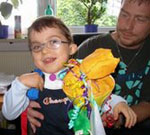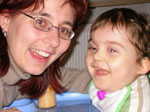CHARGE Syndrome: the daily battles of Jonas
LIVING WITH A RARE DISEASE
 Jonas is the first-born child of Heiko and Claudia Junghans, a lively young couple living in a small village near Nuremberg, Germany. Even if ultra sounds during the pregnancy revealed some abnormalities – a cleft lip, the baby’s stomach being empty all the time – an amniocentesis reassured the parents. There was nothing wrong. But right after his birth, the family’s ordeal started. “Jonas was born 6 weeks early, in May 2004, during a trip to my parents in law. We were 300 kms away from home. Jonas had his first operation the day after his birth. Day after day the doctors found new things that were wrong with him. After 2 months we moved with Jonas to another clinic near our home where Jonas stayed for another 3 months,” recalls painfully Claudia Junghans. Many tests and analysis were done but no diagnosis was reached. “Jonas was 8 months old when we had our first appointment with the geneticist. He was a very nice doctor and just by looking at Jonas, he told us that our son was a CHARGE child. We did a DNA test which confirmed the diagnosis.”
Jonas is the first-born child of Heiko and Claudia Junghans, a lively young couple living in a small village near Nuremberg, Germany. Even if ultra sounds during the pregnancy revealed some abnormalities – a cleft lip, the baby’s stomach being empty all the time – an amniocentesis reassured the parents. There was nothing wrong. But right after his birth, the family’s ordeal started. “Jonas was born 6 weeks early, in May 2004, during a trip to my parents in law. We were 300 kms away from home. Jonas had his first operation the day after his birth. Day after day the doctors found new things that were wrong with him. After 2 months we moved with Jonas to another clinic near our home where Jonas stayed for another 3 months,” recalls painfully Claudia Junghans. Many tests and analysis were done but no diagnosis was reached. “Jonas was 8 months old when we had our first appointment with the geneticist. He was a very nice doctor and just by looking at Jonas, he told us that our son was a CHARGE child. We did a DNA test which confirmed the diagnosis.”
CHARGE syndrome (Coloboma of the eye, Heart defects, Atresia of the choanae, Retardation of growth and/or development, Genital and/or urinary abnormalities, and Ear abnormalities and deafness) is a recognisable pattern of birth defects which occurs in about one in every 9-10,000 births worldwide. It is an extremely complex and rare syndrome, involving extensive medical and physical difficulties that differ from child to child, making the diagnosis even more difficult. The vast majority of the time, there is no history of CHARGE syndrome or any other similar conditions in the family. Babies with CHARGE syndrome are often born with life-threatening birth defects, including complex heart defects and breathing problems. They spend many months in hospital and undergo many surgeries and other treatments. Swallowing and breathing problems make life difficult even after they are discharged from hospital. Most have hearing loss, vision loss, and balance problems which delay their development and communication. The DNA test that Jonas did (called CHD7, after the gene known to cause  CHARGE) cannot confirm the diagnosis of CHARGE syndrome in all cases. Because not all people with CHARGE have a detectable DNA change, CHARGE is still primarily a clinical diagnosis based on physical features.
CHARGE) cannot confirm the diagnosis of CHARGE syndrome in all cases. Because not all people with CHARGE have a detectable DNA change, CHARGE is still primarily a clinical diagnosis based on physical features.
Heiko and Claudia did what every parent with such news does: searching for information. But this German speaking couple was confronted with a language barrier: the scarce resources on CHARGE syndrome were mostly in English. “A year after Jonas was born, in 2005, I set up a forum in German and many families signed up. We thought it was more useful to set up an association and that’s what we did in 2006. In 2007 we had our first meeting with about 80 people and last year we had about 200 people attending the meeting,” says Claudia. The association supports CHARGE patients in German speaking areas, including Austria and Luxembourg.
Life with Jonas is a very challenging one. Breathing, eating, swallowing are daily and never-ending battles. He has practically no sense of smell. He visits a kindergarten five days a week for a few hours and has a nurse to help him. At home, he also has a nurse to watch him during his sleep because of his breathing difficulties. He wears glasses, hearing aids,  undergoes many therapies for his diverse symptoms and hops from eye specialist to ENT doctors. Still, continuous help and love from his parents have helped him overcome many obstacles. This five year old boy loves puzzles, books, listening to music. He identifies all the colours, counts from 1 to 10 and knows nearly all his letters. He even has a favourite TV show! “Of course our life has changed a lot. I stopped working. We can’t do many ‘normal’ things that families do but I have the feeling that Jonas has made me more confident and mature. I am definitely more open than I was before,” confides Claudia who just gave birth to a second child, Juli, born in February 2009. “We have many wishes but what we strongly hope is for Jonas to find a school that accepts him and that he grows up to be more independent. And that his little sister supports him!”
undergoes many therapies for his diverse symptoms and hops from eye specialist to ENT doctors. Still, continuous help and love from his parents have helped him overcome many obstacles. This five year old boy loves puzzles, books, listening to music. He identifies all the colours, counts from 1 to 10 and knows nearly all his letters. He even has a favourite TV show! “Of course our life has changed a lot. I stopped working. We can’t do many ‘normal’ things that families do but I have the feeling that Jonas has made me more confident and mature. I am definitely more open than I was before,” confides Claudia who just gave birth to a second child, Juli, born in February 2009. “We have many wishes but what we strongly hope is for Jonas to find a school that accepts him and that he grows up to be more independent. And that his little sister supports him!”
For more information:
Visit Jonas’ homepage at www.jonas-junghans.blogspot.com
This article was first published in the June 2009 edition of the Eurordis Newsletter.
Author: Nathacha Appanah
Photo credits: © Heiko & Claudia Junghans
